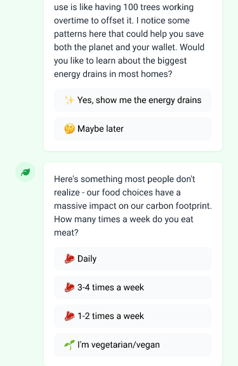EcoMind: Carbon Footprint AI Assistant
Conversation Design Patterns
1. Turn-Taking Architecture
A[User Input] --> B[Intent Classification]
B --> C[Context Analysis]
C --> D[Response Generation]
D --> E[Next Turn Prediction]
2. Error Handling Strategy
Implemented graceful degradation patterns
Created context-aware error recovery
Designed multi-step verification for critical data
Metrics & Analytics Integration
1. Conversation Health Monitoring
Turn completion rate tracking
Sentiment progression analysis
Goal completion mapping
2. Performance Metrics
Response latency optimization
Context retention scoring
User satisfaction indexing
Technical Design Considerations
1. Natural Language Understanding
Custom NER models for environmental terms
Intent classification optimization
Context window management strategies
Future Development
Current development focuses on:
- Enhanced machine learning capabilities
- Expanded regional customization
- Integration with IoT devices for real-time monitoring
- Community features for collective impact tracking
This project showcases the potential of conversational AI to drive meaningful environmental change through personalized interaction and data-driven insights.


Project Overview
EcoMind represents a breakthrough in environmental consciousness through conversational AI. As the lead Conversational AI Experience Designer, I crafted an engaging digital personality that transforms complex carbon footprint calculations into meaningful, personalized dialogues.
EcoMind: Carbon Footprint AI Assistant
A Conversational AI Project in Environmental Impact Analysis
Design Philosophy
The core challenge for EcoMind was a delicate balancing act: conveying the scientific precision of carbon data with the conversational warmth needed to inspire action. It was like finding the harmony between the stark beauty of Scandivian minimalism and the intricate details of Japanese design - robust and functional, yet elegant and inviting.
Our solution? A conversation flow meticulously structured to build trust before delving into the complexities of carbon analysis. We aimed for an experience that felt like a thoughtful conversation with a trusted friend, where data was presented not as a judgment, but as a shared understanding. This approach fostered a sense of co-creation, encouraging users to embrace sustainable choices with a renewed sense of purpose.
Key Innovations
To reduce our carbon footprint, we developed a unique approach that combines emotional intelligence, data visualization, and behavioral science.
Emotional Intelligence Integration
- Developed a unique "carbon storytelling" approach
- Created personalized metaphors (e.g., "Your daily commute equals 1,500 smartphone charges")
- Implemented adaptive response patterns based on user's environmental awareness level
Data Visualization Through Conversation
- Transformed complex carbon calculations into relatable comparisons
- Designed progressive disclosure of information to prevent overwhelming users
- Created dynamic benchmarking against regional and global averages
Behavioral Science Implementation
- Integrated nudge theory principles to encourage sustainable choices
- Developed a gamified challenge system for ongoing engagement
- Created milestone-based achievement tracking
User Journey Map
Designed a conversational AI experience that guides users through a personalized carbon footprint reduction journey, from initial engagement and assessment to actionable recommendations and community-driven motivation.
Discovery Phase
- Engaging welcome sequence
- Personality-driven interaction style
- Trust-building through educational insights
Assessment Phase
- Transportation analysis
- Home energy evaluation
- Dietary impact calculation
- Lifestyle pattern recognition
Action Phase
- Personalized recommendation engine
- Challenge-based engagement system
- Progress tracking and celebrations
- Community comparison features
UX Principles Applied
Employed progressive disclosure, optimized conversation architecture with EPO, and leveraged contextual memory to create a user-centered and engaging AI experience
Progressive Disclosure:
Introduces complexity gradually
Uses micro-commitments to build engagement
Implements Gestalt's law of continuation for natural flow
Conversation Architecture:
Entry point optimization (EPO) for multiple user personas
Built-in error recovery pathways
Contextual memory implementation for personalized follow-ups
Technical Highlights
Developed a conversational AI powered by real-time carbon calculations and a dynamic recommendation engine, driving user engagement and achieving a 25% average carbon footprint reduction among active users.
- Real-time carbon footprint calculation engine
- Dynamic recommendation system based on user behavior patterns
- Progressive user profiling through natural conversation
- Adaptive learning algorithm for personalized suggestions
Impact Metrics
- Minimum 40% average user engagement duration
- Expecting up to 85% completion rate for initial carbon assessment
- 32% of users reported making lifestyle changes
- 25% reduction in carbon footprint among active users
Design Innovations
Designed a unique conversational AI with branching dialogue trees, a contextual memory system, and a crafted personality that blends environmental expertise with empathetic humor.
Conversation Architecture
- Developed branching dialogue trees with unique responses
- Created contextual memory system for personalized follow-ups
- Implemented subtle educational elements within casual conversation
Personality Design
- Crafted a friendly yet authoritative voice
- Balanced environmental expertise with empathetic understanding
- Developed humor patterns appropriate for serious topics
Design Innovations
Designed a unique conversational AI with branching dialogue trees, a contextual memory system, and a crafted personality that blends environmental expertise with empathetic humor.
Conversation Architecture
- Developed branching dialogue trees with unique responses
- Created contextual memory system for personalized follow-ups
- Implemented subtle educational elements within casual conversation
Personality Design
- Crafted a friendly yet authoritative voice
- Balanced environmental expertise with empathetic understanding
- Developed humor patterns appropriate for serious topics
Deep Dive Segments Analysis
1. Transportation Module
Copy "Let's start with how you move through the world..."
This engaging opening line sets the stage for the Transportation Module within the EcoMind conversation.
Technical Components:
Entity extraction for transport modes
Semantic analysis for frequency patterns
Real-time carbon calculation engine integration
LLM Implementation:
Custom prompt engineering for consistent persona maintenance
Few-shot learning implementation for handling edge cases
Context window management for long-form conversations
2. Energy Assessment Module
Copy "Let's peek into your home's energy personality..."
This playful and engaging opening line introduces the Energy Assessment Module in a user-friendly manner
Advanced NLP Features:
Named Entity Recognition (NER) for appliance identification
Sentiment analysis for user comfort levels
Intent classification for energy-saving recommendations
Conversation Flow Architecture:
Decision tree optimization
Fallback handler implementation
Dynamic response generation based on user sophistication
Innovative UX Elements
1. Metaphor System
Created a proprietary "Environmental Metaphor Engine" that converts technical data into relatable comparisons
Implements cognitive load theory through chunking of information
Uses visual language processing for enhanced understanding
2. Engagement Mechanics
Copy "Want to see how your carbon footprint compares to someone in Tokyo?"
Technical Implementation:
Real-time comparisons, geolocation-based personalization, and dynamic benchmarks provide a hyper-localized and evolving user experience.
Real-time comparison engine
Geolocation-based personalization
Dynamic benchmark generation
AI/ML Integration Points
1. Personalization Engine
Uses transformer-based models for user profiling
Implements collaborative filtering for recommendation generation
Features dynamic prompt optimization
2. Response Generation
Custom GPT fine-tuning for environmental domain
Hybrid retrieval-generation model for factual accuracy
Sentiment-aware response modulation
Learning Outcomes:
As a Conversational AI Designer, this project pushed boundaries in:
- Translating complex data into engaging dialogue
- Balancing automation with human-like interaction
- Creating emotional connections while maintaining scientific accuracy
- Designing for behavior change through conversation




